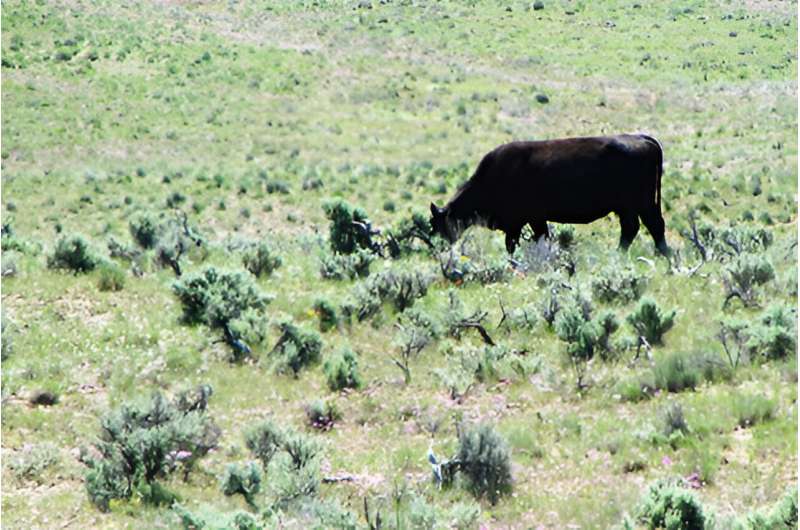This article has been reviewed according to Science X's editorial process and policies. Editors have highlighted the following attributes while ensuring the content's credibility:
fact-checked
peer-reviewed publication
trusted source
proofread
Scientists reveal strategically applied livestock grazing can benefit sagebrush communities

While a cow grazing in a field isn't typically remarkable, United States Department of Agriculture scientists have identified potential ecological benefits of strategically applied livestock grazing in sagebrush communities across U.S. western rangelands.
As recently published in the journal Ecosphere, the collaborative research effort among Agricultural Research Service (ARS) rangeland scientists at Burns, Oregon, and Fort Collins, Colorado, challenged the outdated dogma that livestock grazing in the sagebrush steppe always negatively impacts these ecosystems and, in fact, can convey desirable outcomes, particularly in regard to limiting both wildfire risk and invasive annual grasses.
In addressing these ecological challenges, ARS scientists discovered that strategically applying livestock grazing prior to the occurrence of climate-induced wildfires can modify sagebrush steppe characteristics in ways that decrease fire probability and severity in the communities, promote biodiversity while reducing postfire annual grass invasion, fire-induced loss of native bunchgrasses, and fire damage to soil biocrusts, the collection of bacteria, fungi and mosses on the soil surface.
The ARS team compared moderately grazed and ungrazed sagebrush steppe and observed the grazing induced shorter flame lengths, slower rates of fire spread, and smaller burning fronts.
Similarly, strategic grazing in annual grass-dominated rangelands reduced flame length and rate of spread—modifications that resulted in safer and more effective fire suppression. Still another benefit of modified fire characteristics, the scientists reported, is a decrease in the area burned and overall mosaic of burned and unburned patches.
Grazing by non-native livestock such as sheep, cattle and horses dates back to the mid-to-late 1800s by Europeans. These early practices were not ecologically sustainable and led to widespread overuse and degradation to include loss of perennial grasses and forbs, reduced biodiversity, erosion, overabundant unpalatable species, and non-native plant invasions.
"There were concerns about the negative consequences of non-native livestock grazing in sagebrush communities, especially since these communities are experiencing unpreceded threats from invasive annual grasses, altered fire regimes, and climate change," said Kirk Davies, ARS rangeland scientist.
"But strategically applied grazing can spur desirable social-ecological outcomes such as reduced non-native annual grass invasion, decreased wildfire probability and spread, reduced fire suppression cost, and prevent undesirable ecological transformation post-fire."
Davies' findings also indicated that grazing can modify competitive relationships in introduced bunchgrass seeding to favor native species recruitment. This can be particularly valuable for reestablishing sagebrush, a critical shrub for many native wildlife species.
With careful attention to the timing, duration, frequency, and intensity of use needed to meet vegetation objectives, strategic grazing has the potential to reduce the detrimental impacts of invasive annual grasses, promote native species in introduced grasslands, and encourage native shrub recovery.
"Recognizing livestock grazing as a tool that can achieve desired outcomes could improve our ability to achieve meaningful rangeland management outcomes in sagebrush and likely other rangeland communities," Davies said.
More information: Kirk W. Davies et al, Ecological benefits of strategically applied livestock grazing in sagebrush communities, Ecosphere (2024). DOI: 10.1002/ecs2.4859
Journal information: Ecosphere
Provided by Agricultural Research Service




















